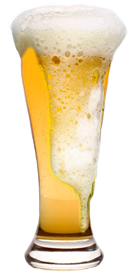A Great Gas Blend Means a Great Pint.
There are many components in a draught beer system that influence pouring a great pint of beer. Using the proper gas mixture is one of the most important factors.
All draught beers are brewed with a certain amount of carbon dioxide dissolved into the beer and it is important to maintain that level of CO2. The BGS system provides two blends of gas. A 75% nitrogen and 25% CO2 for "nitrogenated" beers like Guinness, Kilkenny, Caffrey's etc which have a relatively low carbonation content (1.2 volumes) and a 50% N2 and 50% CO2 for domestic and craft beers which have a higher CO2 content (approx. 2.5 volumes). Maintaining the carbonation content in beer allows you to pour the proper "2 finger" head on every beer from the top to the bottom of each keg resulting in increased yields and profits for your establishment.
Nitrogen is the perfect choice as a second gas for several reasons. Many beers use nitrogen as an ingredient. The best-known example and the originator of the concept is Guinness Stout on draught. The Guinness brewers go to great pains to dissolve nitrogen in the beer, which improves the quality of the head. Nitrogen (N2) is the ingredient responsible for the "whippedcream-like" foam in Guinness and other beers like Kilkenny, Boddingtons, Caffrey's, and Murphy's Stout. N2, in the right proportion, is required in the gas used to push these beers. Without it, the dissolved N2 would come out of solution and these beers would not be the same.
Nitrogen is one hundred times harder to dissolve in beer than CO2. While this is a challenge for the brewers mentioned above, it makes N2 a good choice for dispensing "normally carbonated" beers. N2 is not readily absorbed, does not react chemically under normal circumstances and will not affect beer flavours. N2 is 78% of the air we breathe, making it safe and readily available. A relatively new product called a "Nitrogen generator" is available from several sources in the Canada today. Nitrogen generators filter relatively pure N2 from air and can be a very economical source of Nitrogen. They can be built or used with a blending device and a CO2 source to provide all the gas for any bar or facility.





